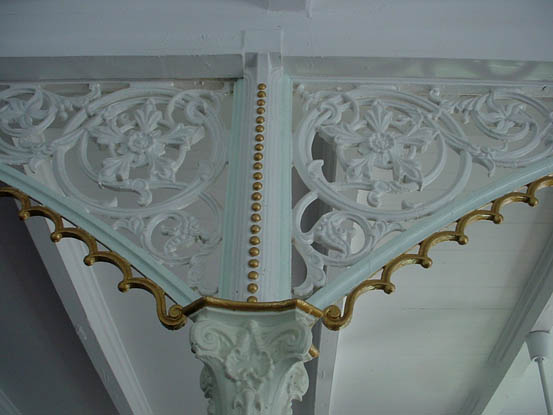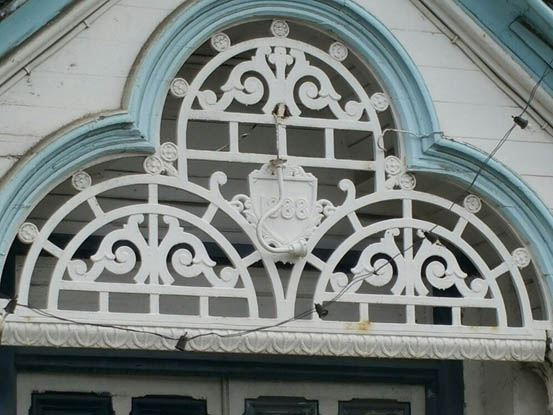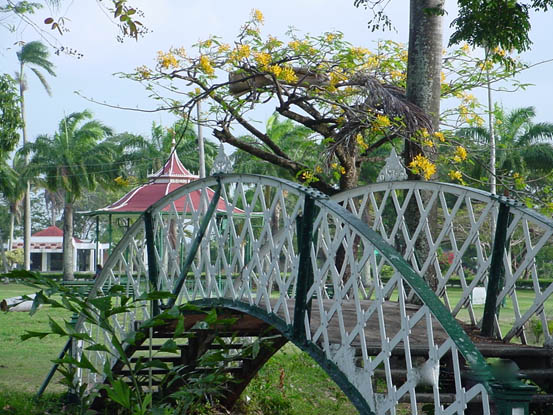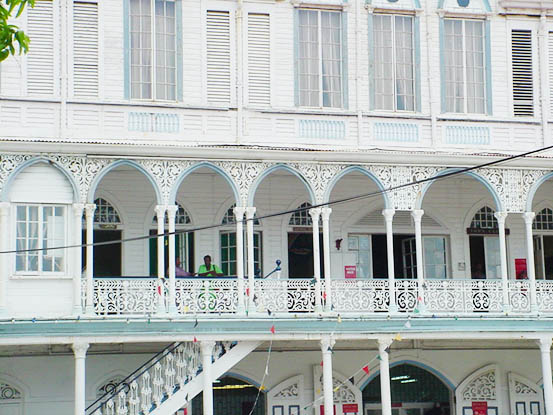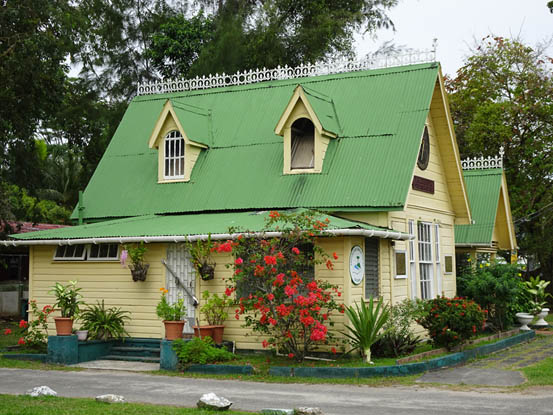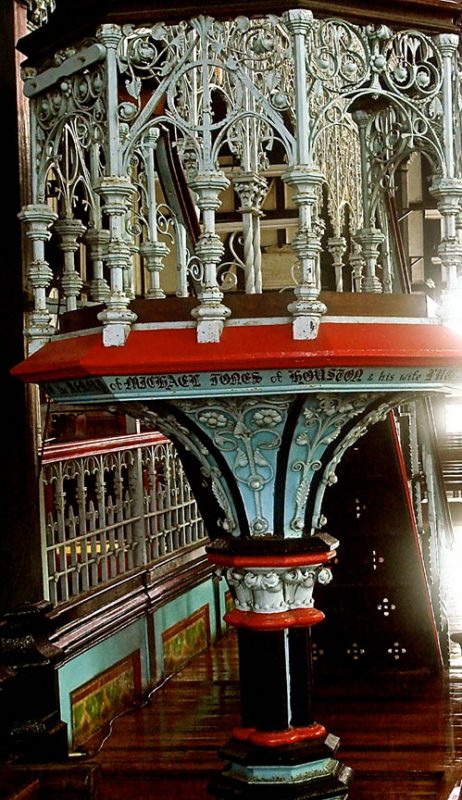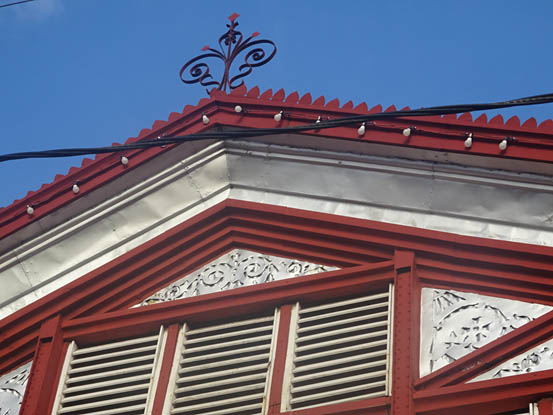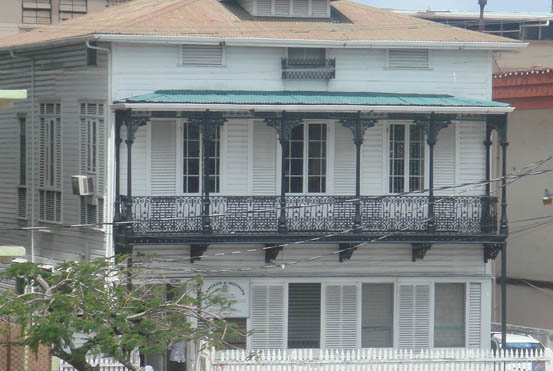By Clive W. McWatt
Ironwork is associated with buildings in relation to structural engineering such as reinforced concrete or steel box girders and building frames. Ironwork is also used as a security measure for window grills or gates to maintain privacy and security. Yet ironwork can be used as a decorative feature to enhance and complement the overall style of a building.
Looking around Georgetown and its buildings, we can still find elements of cast ironwork and ironmongery that originate back to the nineteenth century. The ironwork was partly structural but mostly decorative. Most of these iron structures have stood the test of time and have weathered well in spite of minimal maintenance. Compare this state to the timber structures which have been more susceptible to decay in a tropical climate. Similar iron structures found in the Caribbean Islands, like Barbados, have suffered corrosion from exposure to a salty maritime environment.
Iron Imports
The origins and use of ironwork in the nineteenth century buildings in Guyana deserve further study and understanding. Perhaps the University of Guyana’s faculty of Architecture and Technology has the facility to further research this topic.
Why and how was iron imported into Guyana?
What were the influences which led builders in Guyana to use ironwork in conjunction with their designs of timber buildings?
It is thought that much of the iron imported into Demerara was in the form of ballast carried in the empty cargo holds of the merchant ships returning to Georgetown. Some cast iron would also have arrived in the form of finished manufactured products from foundries in England and Scotland.
The finished Victorian Ironwork designs found around Georgetown were also made up from designs copied from pattern books produced by foundries such as MacFarlane in Scotland, but the local Guyana foundries must have produced much of the architectural ironwork. Two of the known foundries in Guyana were the Demerara Foundry Co. and Sprostons Ltd; Sprostons built the Georgetown Town Hall (City Hall) and it would be interesting to know whether the Sprostons foundry produced any of the ironwork designs which adorn the City Hall.
Building with iron
Wrought Iron was used in medieval Europe and cast iron widely produced and used during the Industrial Revolution in Great Britain.
Wide roof spans like the London Victorian railway termini and Paxton’s Crystal Palace were structurally engineered in cast iron. These constructions showed off the exuberance of the metal to achieve both structural strength and aesthetic design. Decorative ironwork is also to be seen in Georgian and Victorian public and domestic buildings.
In the French Colonial era, architecture in places like Port Louis and Curepipe, Mauritius, also focused on the ornate, with intricate wrought iron balconies adorning stately town houses and government buildings, evoking a feel akin to New Orleans.
The use of ironwork in buildings in Colonial British Guiana in the nineteenth century was adopted by architects and builders, who were influenced by Gothic, Renaissance and other international eclectic building styles.
Stone or brick work was a more common combination with ironwork; this is seen in the stone built Georgetown public buildings like the Parliament Building (Public Buildings), the Lighthouse, the Magistrates’ Courts, the Hand-in-Hand Building and the former Booker McConnell Head Office building in Water Street.
Stabroek Market
When one thinks of an iron building in Georgetown the Stabroek Market uniquely fits the bill.
The iron framed market building was designed by the American engineer Nathaniel McKay and constructed by the Edgemoor Iron Company of Delaware, USA over the period 1880-1881. The construction of the iron and zinc structure was completed in 1881.
Ignatius Scoles, the architect of City Hall, describes the Stabroek Market as “a mere constructive piece of zinc, iron and engineering departing from the traditional timber structures erected in Georgetown.”
In one of the eaves of the Water Street façade of the market building, we find architectural features associated with timber – moldings, fret designs, and louvers meeting at an apex with a finial; the lace-like perforated panels do justice to the metal designs. This is the work of a tinsmith, blacksmith and metal worker, rather than that of a joiner and a carpenter.
Botanic Gardens
The Promenade and Botanic Gardens both exhibit some our finest public ironwork structures and furnishings which were introduced into the landscaping of the gardens. These cast iron constructs have endured the vicissitudes experienced by the gardens’ horticultural changes over many years. The ironwork structures are functional but nevertheless have a cherished whimsical appeal – whether it be the noble metal cupolas and iron balustrades in bandstands or the trellised cast iron arc design of the ‘Kissing’ Bridges over the ponds or the massive iron gates at the main entrance of the Botanic Garden.
Bridges, railings and street furniture
In the city centre of Georgetown, we can still find handsome examples of cast iron bridge railings and culverts over the existing canals.
Most of our older nineteenth century buildings still retain their original cast iron railings and fences. This heritage of foundry craftsmanship should be appreciated and preserved; compare with the fate of the iron railings removed from London properties during the World Wars when the iron was requisitioned to be smelted down for munitions.
There were once the two beautifully sculptured cast iron drinking fountains erected in 1887 at either end of Main Street (High Street); they were exquisite examples of Victorian metal work design from the MacFarlane Foundries of Glasgow.
Other visible manifestations of ironwork can be found on the roof ridges of buildings. The ridges often carried cast iron decorative crestings and finials at the apex of the roof to deter crows and other birds from perching and fouling the rain water run-off which may be collected in water vats in the yard.
Interior decoration and furnishing
Some of the most intricate wrought iron designs are to be found in our major church buildings.
St George’s Cathedral, 1894, is renowned for its lofty timber structure but inside we find a profusion of ironwork in the ecclesiastical furnishings. There is the wrought iron corona of lights above the central altar was presented by Her Majesty Queen Victoria; the fine wrought iron chancel screen; and the magnificent wrought iron pulpit, which was presented to the Cathedral in memory of the Jones Family of Plantation Houston.
Likewise in the interior of Christ Church in Waterloo Street, another Anglican foundation, there is a fine interior display of wrought iron furnishings and a decorative wrought iron chancel screen.
Notable interior cast ironwork in public buildings includes the iron balustrades in the main staircases in the High Court, 1887, and the National Library, 1909. In the domestic setting of the Ballet Room in Woodbine House (now Cara Lodge) there are elegant cast iron beams and brackets which were made in Liverpool and commissioned for house by George Forshaw, a former Mayor of Georgetown.
Iron complements wood
Scoles, in his essay, ‘The Architecture of Georgetown,’ 1883, writes about the art-use of cast iron in our buildings: “… an accompaniment to, or a juxtaposition with ordinary wood work; for iron and wood, like brick and stone, may be brought into the best of building harmony, and be made mutually to assist each other, and furthermore we may add, as if in parenthesis, the more we can see our way to the using of iron, and the method too of preserving it, the better for our buildings generally and for certain ones particularly”
“And for certain ones particularly”, we have Scoles’ own City Hall (Town Hall) in Georgetown, itself designed in 1887. The iconic neo-Gothic wooden structure is enriched and interlaced with elaborate wrought iron designs throughout the building which harmonise completely with the timber structure. Ironically it may be the endurance of the applied and supportive ironwork which stabilises the crumbling wooden fabric of the building.
Ironwork in domestic architecture
While ironwork was applied mostly to our public buildings, there are some unique examples where Iron was incorporated into wooden domestic architecture. The iron balcony known as a ‘widow’s walk’ surrounding the tower was a feature in some of the grander timber mansions built at the turn of the twentieth century; the best observed example is the house at the corner of Church and Camp Streets, now the home of Go-Invest.
However, to witness the full exuberance of ironwork in harmony with wooden domestic architecture we look to the houses of John Bradshaw Sharples, whose work stands facile princeps.
The three houses that he designed and built—two in Queenstown (Forshaw Street and Anira Street) and one in Duke Street, Kingston—all carry elaborate cast iron external staircases and balustrades. These elements became his signature on the buildings he constructed. Decorative wrought iron designs are added to the roof ridges and in the Juliet balconies, which enliven the timber facades and harmonise with the fenestration. A closer look at the façade of 93 Duke Street, Kingston reveals iron medallions applied to the timber cladding.
Ironwork has been a visible feature of our architecture and surroundings from the early nineteenth century. Iron as a material has the structural quality and function and lends itself to be wrought into aesthetic designs.
The durability and sustainability of iron has meant its survival amidst our constantly changing built environment. As a decorative feature in architecture, and in the adornment for stone or timber buildings or furnishings or objects, ironwork should be admired and appreciated for the craftsmanship and complementary design feature in our wooden building heritage.
Clive Wayne McWatt was born in Guyana in 1946. He left in 1963 to continue studies in the UK. After postgraduate studies in Library and Information Science he joined the Shell Group Companies as Librarian, Shell Centre London and Information Manager. After a varied career with Shell he is now retired and lives in London.
